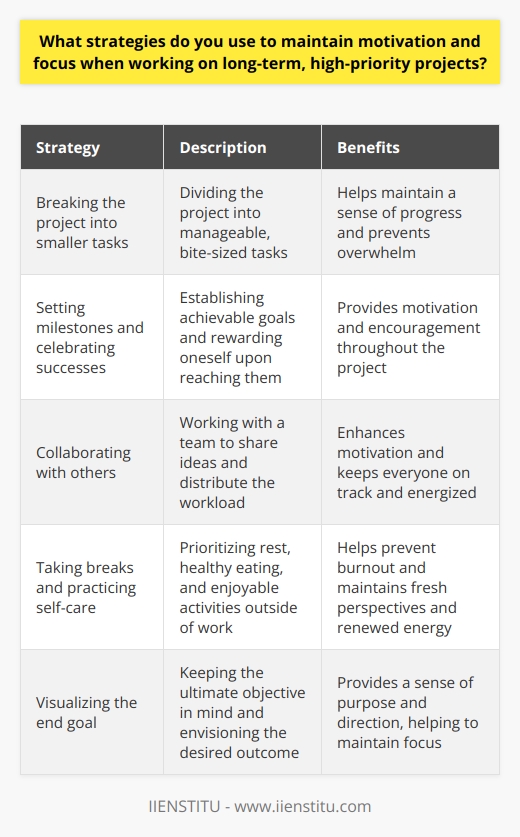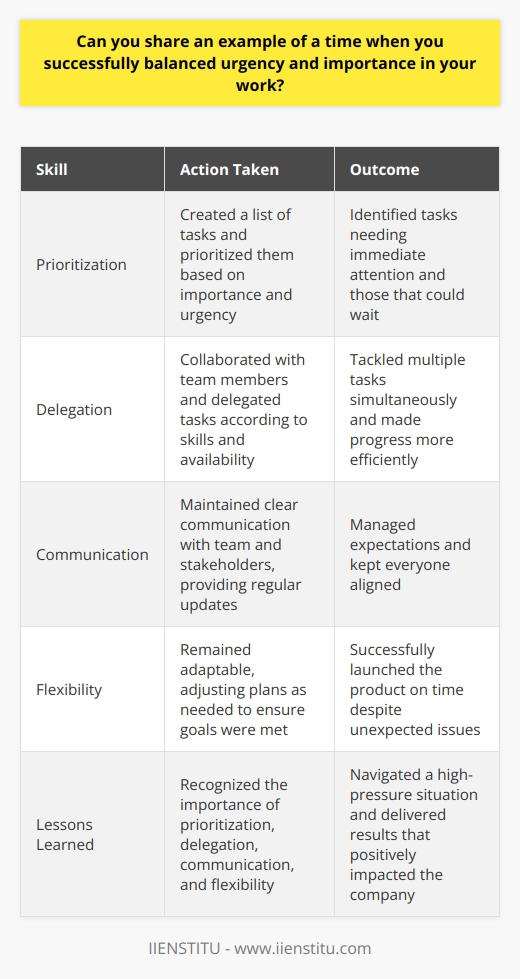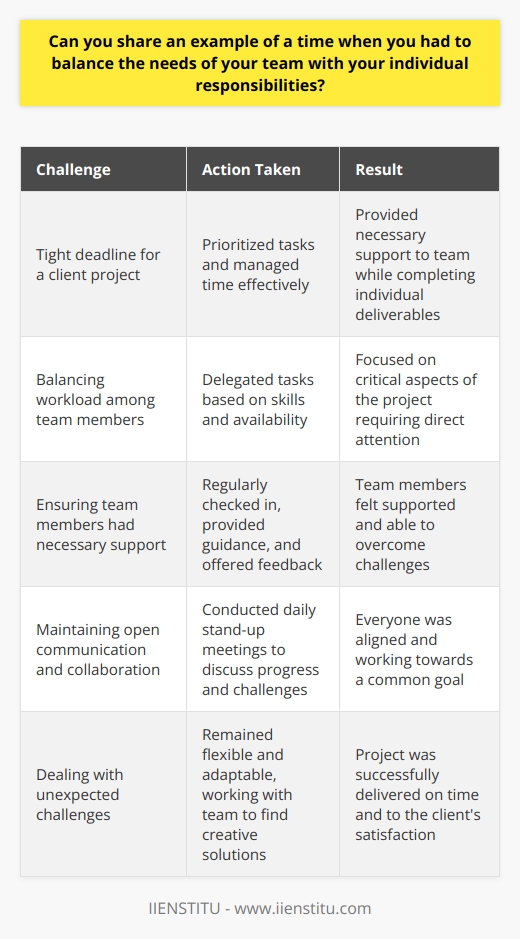
Time management is a vital skill that determines not only our work's efficiency but also our overall life balance. One of the most critical aspects of time management is finding a balance between urgency and importance—a challenge often faced by professionals from all walks of life.
Related Course: Time Management Online Course
So then, the big question presents itself: how do you balance urgency vs. importance in time management? Let's delve right into this.
Why is this Interview Question Asked: How Do You Balance Urgency vs. Importance in Time Management?
This question is a favorite among recruiters because it serves as a window into your time management skills. Employers are interested in understanding your approach towards prioritizing tasks and how efficiently you can manage your time under pressure.
By asking this, they want a glimpse into your strategic thinking skills—how you discern between what needs immediate attention and what's crucial for long-term organizational success.
Purpose of the Question
The overarching purpose of this question is to evaluate your decision-making skills. Interviewers want to see if you can distinguish between tasks that are important but not urgent vs. tasks that are urgent but quite possibly, not important.
It helps them ascertain if you have a strategic vision to prioritize tasks that will provide the most significant gains, despite looming deadlines on other less significant tasks.
Interview Question: How Do Deadlines Affect Problem Solving?
Interview Question: Describe a Time Management Mistake and Your Learning From It.
At What Interview Level is it asked?
The urgency vs. importance balance is a concern for professionals across all career levels, from interns to CEOs. Therefore, expect to encounter this question in job interviews regardless of your career stage—entry-level, mid-level, or senior level.
Pursuing this line of questioning helps interviewers recognize both your technical competencies and your capability to think strategically and objectively under pressure.
What Kind of Answer is Expected from the Candidate?
To ace this question, show the interviewer that you have a considered approach for balancing priority and urgency. Explain your understanding of the concepts and how you differentiate between what is urgent and what is important.
Here’s how: Urgency relates to things demanding immediate attention, often linked with deadlines and timelines. Importance, on the other hand, pertains to tasks that contribute to long-term objectives and goals. A task could be both urgent and important, just one of the two, or neither.
While answering, it's resourceful to mention a robust system or framework you employ for managing your time effectively, like the Eisenhower Matrix or the Pareto Principle.
Possible Responses to Consider
One of the possible responses could be:
"I adopt the Eisenhower Matrix in managing my tasks. This method helps me delineate tasks into four categories: important and urgent, important but not urgent, urgent but not important, and not urgent and not important. I focus first on tasks that are both urgent and important, then shift my focus to tasks that are important but not urgent. Tasks that are urgent but not important are delegated where possible, and tasks that are neither urgent nor important are scheduled for later or sometimes removed altogether."
A second possible response could be:
"I'm a firm believer of the Pareto Principle, or the 80/20 rule. I try to identify the 20% tasks that will yield the 80% results and focus my energies there, effectively balancing urgency and importance."
To round it off, assure the interviewer that you're flexible and adaptable, capable of responding effectively to changes in task urgency or importance as circumstances evolve. Proving that you can balance urgency vs. importance in time management is a powerful display of your organizational abilities, decision-making prowess, and ultimately, your professionalism.
Comparative Analysis Between Urgency and Importance in Time Management
Strategies for Balancing Urgent vs Important Tasks in Time Management
Impact Assessment of Urgency Vs. Importance in Achieving Time Management Goals
Similar interview questions:
What strategies do you use in time management to balance urgent tasks with important ones?
How do you differentiate between urgent tasks and important tasks in time management?
Can you provide any tactics to prioritize importance over urgency in time management?
How do you manage your time to ensure both urgent and important tasks are accomplished
What is your method in striking a balance between urgency and importance in managing your schedule or tasks?
How do you go about managing time between tasks that are urgent and those that are important?
Do you prioritize urgency or importance while managing your time, and how do you maintain the balance?
How do you prevent urgent tasks from overshadowing important ones in time management?
Can you explain the process of balancing urgency with importance in the domain of time management?
In your time management strategy, what methods do you employ to ensure both urgent and important tasks are balanced and completed?
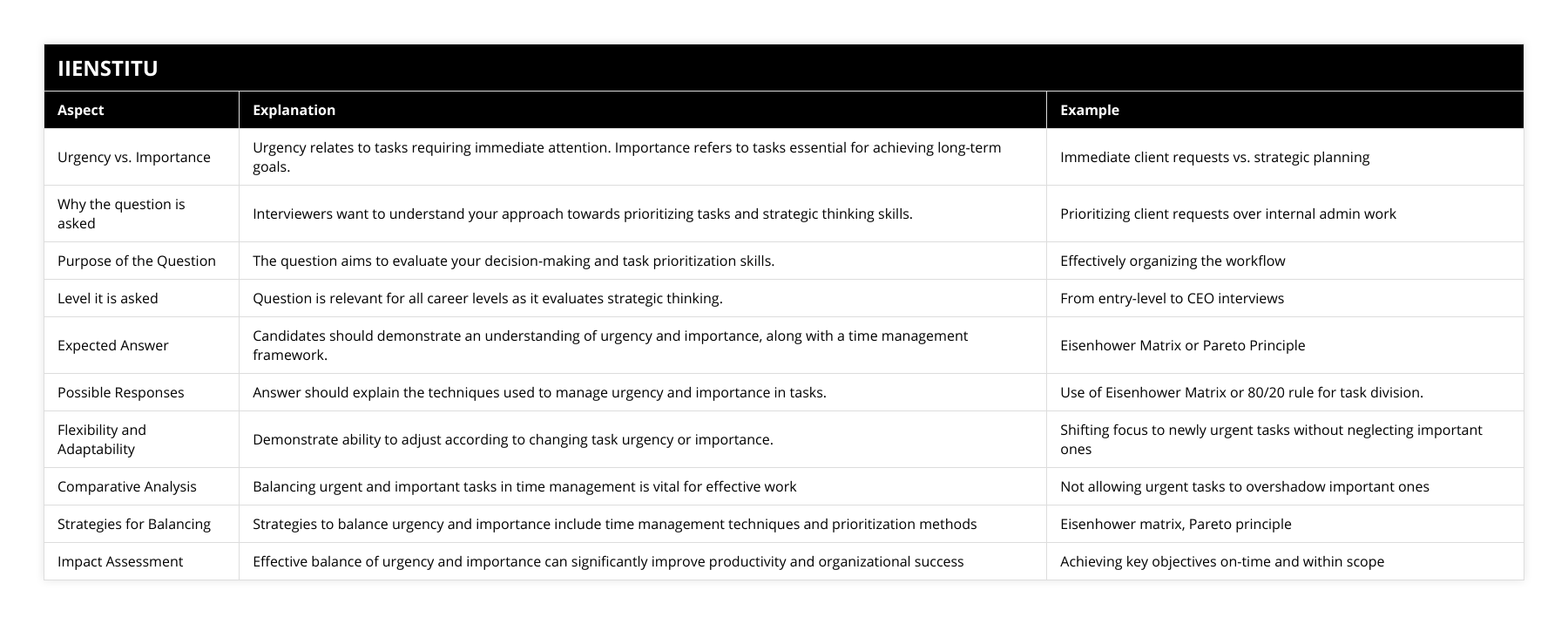
Frequently Asked Questions
How do you prioritize tasks when faced with multiple deadlines?
When faced with multiple deadlines, I prioritize tasks based on their importance and urgency. I consider factors such as the potential impact on the company, the consequences of missing the deadline, and the time required to complete the task.
Assessing Importance and Urgency
First, I evaluate each task and determine its level of importance and urgency. I ask myself questions like, "What will happen if this task isn't completed on time?" and "How does this task contribute to the overall goals of the company?"
For example, when I was working on a project with a tight deadline, I realized that one of the tasks was critical to the project's success. I prioritized that task and worked on it first, even though it was more challenging and time-consuming than the others.
Creating a Plan of Action
Once I have assessed the importance and urgency of each task, I create a plan of action. I break down larger tasks into smaller, manageable steps and set mini-deadlines for each step. This helps me stay on track and ensures that I'm making progress towards the final deadline.
I also communicate with my team members and keep them informed about my progress. If I anticipate any delays or issues, I let them know as soon as possible so we can work together to find a solution.
Staying Flexible and Adaptable
Despite my best efforts to plan and prioritize, sometimes unexpected challenges arise. In these situations, I stay flexible and adaptable. I reassess my priorities and adjust my plan accordingly.
I remember a time when I was working on a project and a last-minute request came in from a client. I had to shift my priorities and work on the new request while still meeting the original deadline. It was stressful, but by staying calm and focused, I was able to deliver both tasks on time.
In summary, when faced with multiple deadlines, I prioritize tasks based on their importance and urgency, create a plan of action, and stay flexible and adaptable. By doing so, I'm able to manage my workload effectively and deliver high-quality results.
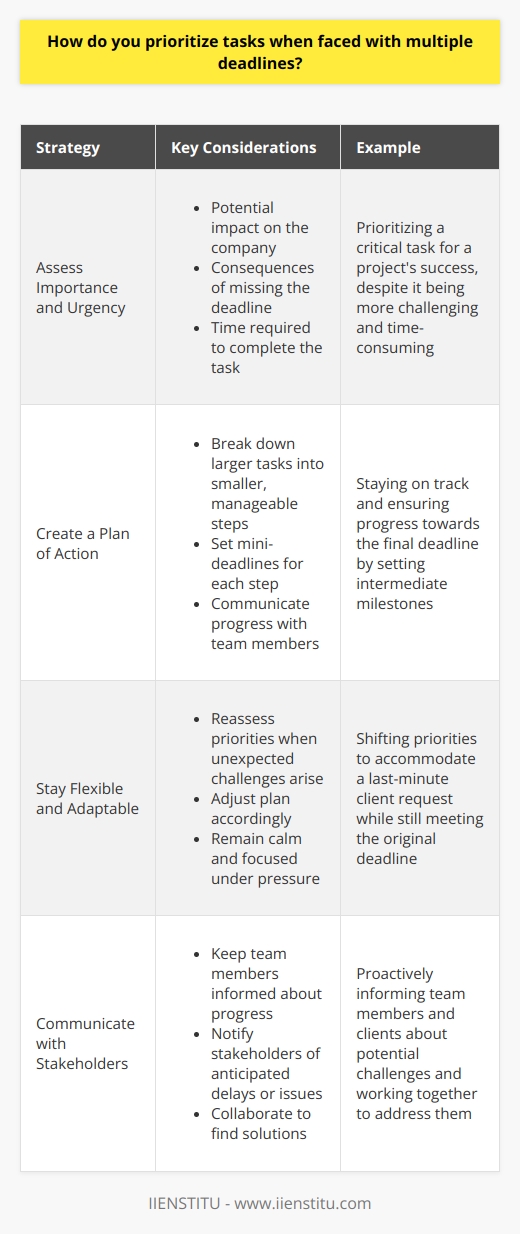
What strategies do you use to manage your time effectively?
I've found that the key to effective time management is prioritizing tasks and staying organized. Every morning, I make a to-do list and rank items by importance and urgency. This helps me focus on the most critical tasks first and avoid getting sidetracked by less essential ones.
Blocking Out Time for Deep Work
For complex projects requiring deep concentration, I block out dedicated time slots in my calendar. During these focused sessions, I eliminate distractions like email and social media notifications. It's amazing how much more I can accomplish when my attention isn't fragmented.
Leveraging Productivity Tools
I'm a big fan of using technology to streamline my workflows. Tools like Trello for project management, RescueTime for tracking how I spend my hours, and Forest for boosting focus have been game-changers. They automate a lot of the tedious aspects of staying on top of things.
Taking Strategic Breaks
It may sound counterintuitive, but I've discovered that taking short breaks actually makes me more productive overall. When I step away from intense tasks for a few minutes to stretch, grab a healthy snack, or do some deep breathing exercises, I return feeling re-energized and ready to tackle challenges with a fresh perspective.
Protecting Personal Time
Finally, I firmly believe in maintaining a healthy work-life balance. I set clear boundaries around my personal time, whether that's enjoying hobbies in the evenings or unplugging entirely on weekends. Recharging outside of work ultimately enables me to be more focused and efficient when I am on the job.
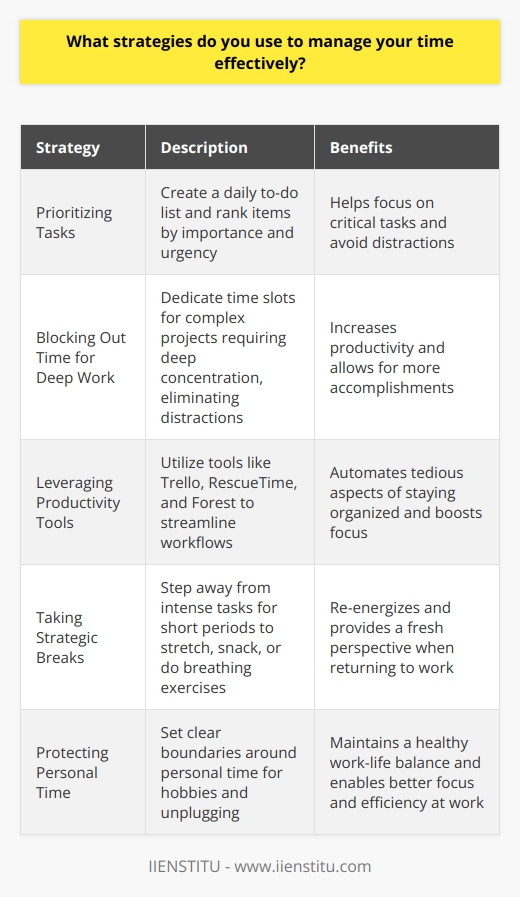
How do you determine which tasks are most critical?
When determining which tasks are most critical, I start by considering the overall goals and objectives of the project. I ask myself, "What absolutely must be accomplished for this project to succeed?" This helps me identify the core deliverables that are essential to meeting the project's purpose.
Prioritizing Based on Impact
Next, I assess each task's potential impact on achieving those key objectives. Tasks that have the greatest influence on reaching our goals are given higher priority. For example, when I was leading a website redesign project last year, I prioritized tasks like defining the site architecture and creating wireframes over less critical tasks like selecting stock photos.
Considering Dependencies and Deadlines
I also look at task dependencies and deadlines when prioritizing. If a task is a prerequisite for other important tasks, it becomes more critical. Similarly, tasks with looming deadlines may need to be bumped up in priority. In the website redesign project, I had to prioritize building out the content management system early on because all other development tasks depended on it.
Staying Flexible and Communicating
Finally, I stay flexible and communicate openly with my team. Priorities can shift as new information emerges or roadblocks arise. I regularly check in with teammates to get their input on task prioritization and make adjustments as needed. Collaboration and adaptability are key to keeping the most important work on track.
In summary, I determine critical tasks by aligning them with key goals, evaluating their impact and dependencies, and maintaining flexibility through team communication. This approach helps me stay focused on what matters most for project success.
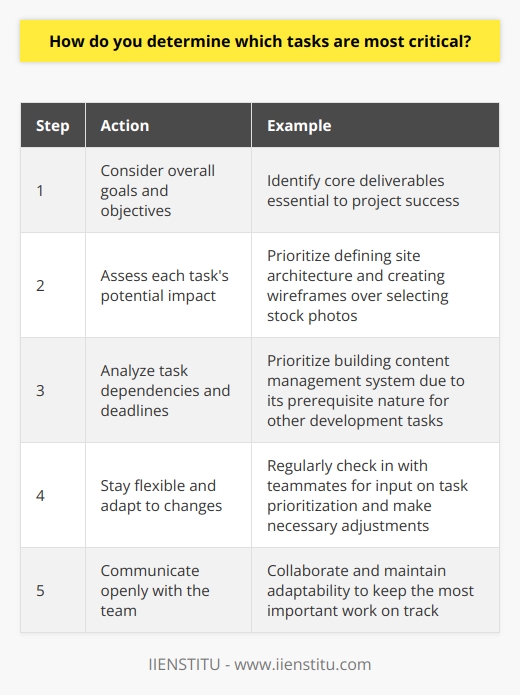
Can you give an example of a time when you had to juggle competing priorities?
As a project manager, I often face competing priorities and tight deadlines. One particularly challenging situation involved managing three projects simultaneously, each with different stakeholders and requirements.
Prioritizing and Planning
To tackle this challenge, I first assessed the urgency and importance of each project. I then created a detailed plan, breaking down tasks and allocating resources accordingly.
I communicated openly with my team and stakeholders, setting clear expectations and timelines. This helped everyone stay on the same page and understand the bigger picture.
Flexing and Adapting
Throughout the process, I remained flexible and adaptable. When unexpected issues arose, I quickly reassessed priorities and adjusted plans as needed.
I also leveraged my team's strengths, delegating tasks based on each member's expertise. This allowed us to work more efficiently and effectively.
Staying Organized and Focused
To stay organized, I used project management tools to track progress and deadlines. I also held regular check-ins with my team to ensure everyone was on track.
Despite the competing demands, I remained focused on the end goal. I kept my eye on the big picture while still attending to the details.
Lessons Learned
Through this experience, I learned the importance of prioritization, communication, and adaptability. By staying organized and focused, we successfully delivered all three projects on time and to the satisfaction of our stakeholders.
This experience strengthened my ability to juggle competing priorities and lead a team through complex challenges. It's a skill I continue to apply in my work every day.
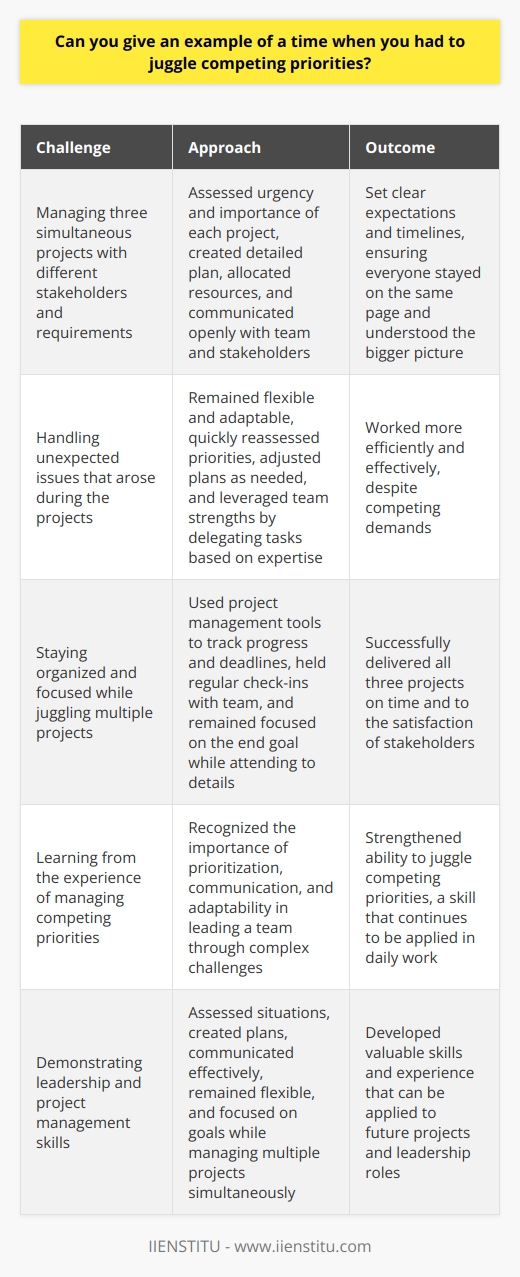
How do you handle unexpected interruptions or emergencies while working on important projects?
When unexpected interruptions or emergencies arise while working on important projects, I remain calm and focused. I quickly assess the situation and determine the best course of action to address the issue at hand.
Prioritizing Tasks
I prioritize tasks based on urgency and importance. If the interruption or emergency requires immediate attention, I communicate with my team and stakeholders about any potential delays in the project timeline.
Delegating Responsibilities
If possible, I delegate tasks to team members who can assist in resolving the issue. This allows me to focus on critical aspects of the project while ensuring that the interruption or emergency is handled effectively.
Maintaining Open Communication
Throughout the process, I maintain open communication with my team, managers, and clients. I provide regular updates on the status of the project and any changes in the timeline due to the unexpected event.
Learning from Experiences
After the interruption or emergency is resolved, I take time to reflect on the experience. I analyze what worked well and what could be improved in the future. This helps me develop contingency plans and strategies to minimize the impact of similar situations on future projects.
By staying organized, communicating effectively, and being adaptable, I can successfully navigate unexpected interruptions or emergencies while ensuring that important projects remain on track.
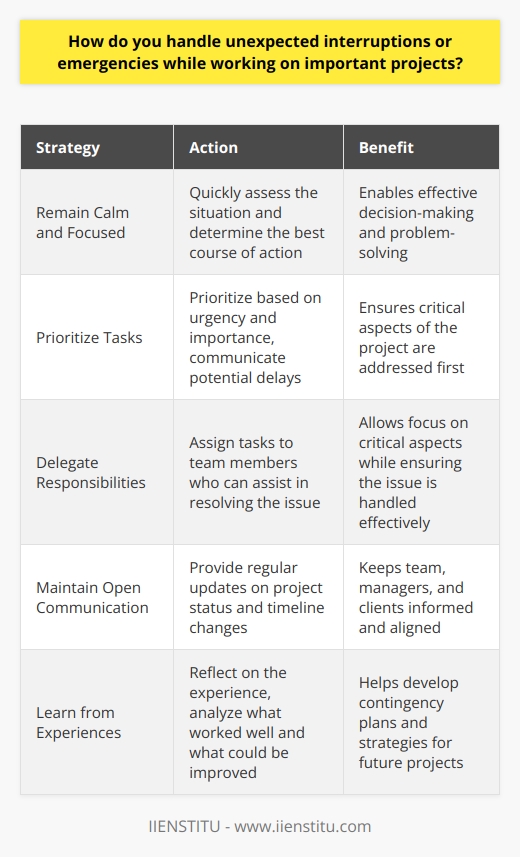
What tools or techniques do you use to stay organized and on track?
I use a combination of digital tools and physical methods to stay organized and on track with my work.
Digital Tools
For managing projects and tasks, I rely on Trello. It allows me to create boards for each project, add tasks as cards, and assign due dates. I also use Google Calendar to schedule meetings and set reminders for important deadlines.
To keep my files organized, I use Google Drive. I create folders for each project and store all relevant documents there. This makes it easy to access files from any device and share them with colleagues when needed.
Physical Methods
In addition to digital tools, I find that physical methods help me stay focused and productive. Every morning, I write a to-do list in my notebook, prioritizing tasks based on urgency and importance. Crossing items off the list gives me a sense of accomplishment and keeps me motivated.
I also use a bullet journal to track my long-term goals and reflect on my progress. Writing down my thoughts and experiences helps me stay mindful of my personal and professional development.
Communication and Collaboration
Effective communication is key to staying organized when working with a team. I use Slack for instant messaging and updates, and Zoom for video meetings. Regular check-ins with my colleagues ensure that everyone is on the same page and tasks are completed on time.
By combining these tools and techniques, I'm able to stay organized, prioritize my workload, and collaborate effectively with others. It's a system that has worked well for me in my previous roles, and I'm confident it will continue to serve me in this position.
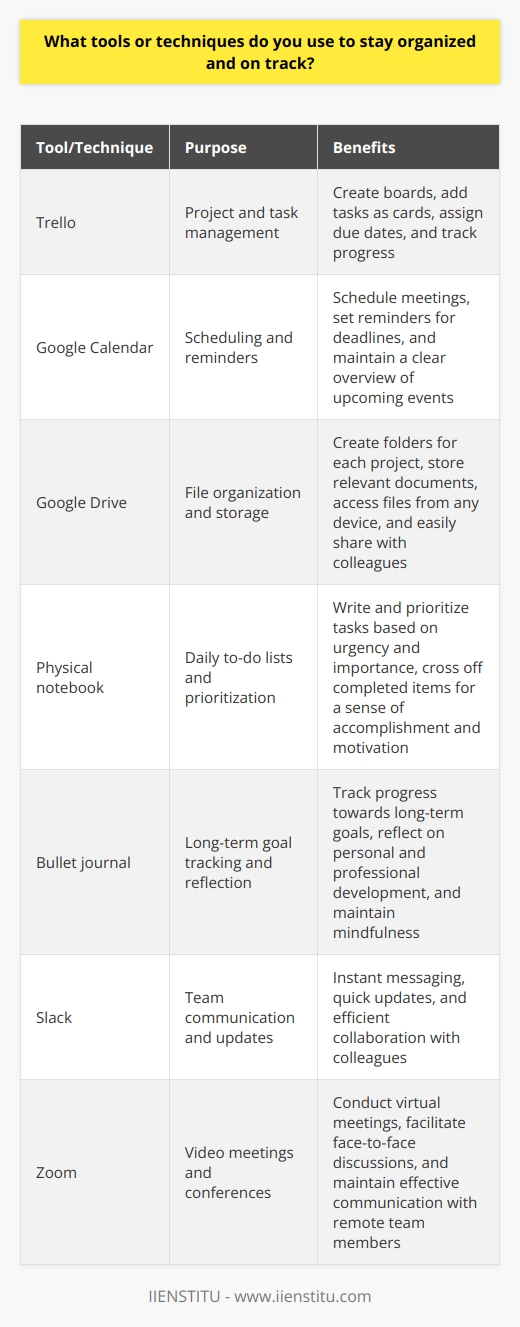
How do you communicate with your team or manager about urgent and important tasks?
When it comes to communicating urgent and important tasks with my team or manager, I always prioritize clarity and efficiency. I believe in being proactive and keeping everyone in the loop from the get-go.
Assessing the Situation
First, I quickly assess the situation and gather all relevant information. I ask myself, "What's the potential impact of this issue?" By understanding the scope, I can communicate more effectively.
Choosing the Right Communication Channel
Depending on the urgency, I select the most appropriate communication channel. For critical matters, I prefer face-to-face discussions or phone calls. This allows for immediate feedback and problem-solving.
If it's less pressing but still important, I might send a detailed email or message on our team collaboration platform. I make sure to clearly outline the issue, its importance, and any proposed solutions.
Being Clear and Concise
When communicating, I strive to be clear and concise. I avoid jargon and get straight to the point. I've learned that managers appreciate when you can quickly summarize the key details.
Proposing Solutions
I always try to come to the table with potential solutions. Rather than just presenting a problem, I offer my thoughts on how we can tackle it. This shows initiative and problem-solving skills.
Following Up
After the initial communication, I make sure to follow up. I keep my team or manager updated on the progress and any new developments. Regular check-ins help ensure everyone stays on the same page.
At the end of the day, effective communication is about being proactive, clear, and solution-oriented. By keeping these principles in mind, I can ensure that urgent and important tasks are addressed promptly and efficiently.

Can you describe a situation where you had to make a tough decision about prioritizing tasks?
In my previous role as a project manager, I faced a challenging situation where multiple high-priority tasks required immediate attention. The timeline was tight, and resources were limited, so I had to make some tough decisions.
Assessing the Situation
I quickly gathered all the relevant information and assessed the impact and urgency of each task. It was clear that some tasks, if delayed, would have severe consequences for the project's success.
Prioritizing Based on Impact
I prioritized the tasks that had the most significant impact on the project's objectives and deliverables. These were the tasks that, if not completed on time, would jeopardize the entire project.
Communicating with Stakeholders
I communicated my decision to the team and stakeholders, explaining the reasoning behind the prioritization. It was crucial to get everyone on the same page and ensure they understood the importance of focusing on the critical tasks.
Reallocating Resources
To ensure the high-priority tasks were completed on time, I reallocated resources from less critical tasks. This meant temporarily postponing some tasks and reassigning team members to work on the urgent matters.
In the end, by making tough decisions and prioritizing effectively, we were able to deliver the project successfully. It wasn't easy, but it taught me the importance of assessing situations objectively, communicating clearly, and being decisive when necessary.
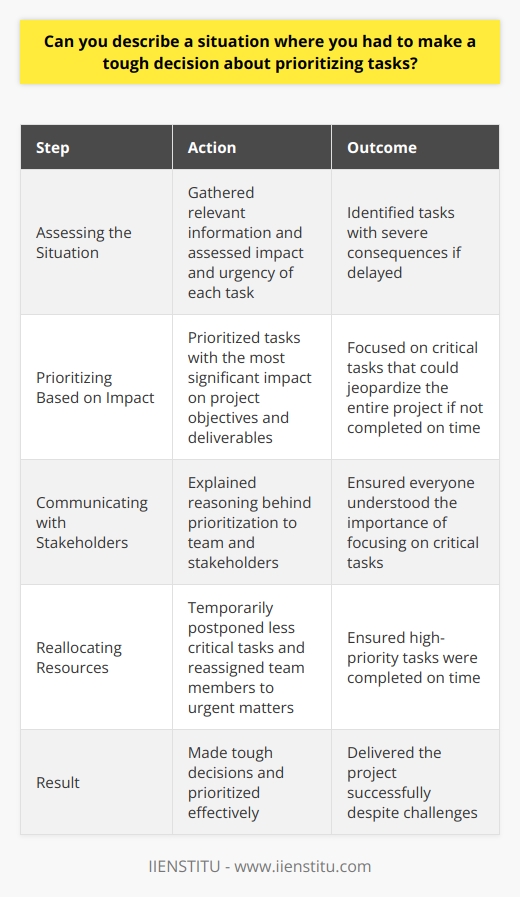
How do you ensure that important long-term projects don't get neglected in favor of urgent short-term tasks?
I have a system in place to ensure that important long-term projects don't get neglected. It involves careful planning, prioritization, and regular check-ins.
Start with a Clear Plan
When I take on a new long-term project, I break it down into manageable phases and set milestones. This helps me visualize the path forward and keep the end goal in sight, even as day-to-day tasks compete for attention.
Prioritize Ruthlessly
I'm vigilant about assessing the urgency and importance of every task that lands on my plate. If something isn't truly critical and doesn't align with my long-term objectives, I'm comfortable saying no or delegating it.
Schedule Regular Progress Check-Ins
To keep long-term projects on track, I block out time on my calendar for regular progress reviews. These check-ins are an opportunity to celebrate small wins, identify roadblocks, and course-correct if needed.
Stay Accountable with a Project Buddy
I've found it helpful to partner with a colleague who's also working on a long-term initiative. We hold each other accountable, share best practices, and provide moral support during challenging stretches.
Communicate Proactively
If I anticipate that urgent short-term demands will impact the timeline for a long-term project, I communicate proactively with stakeholders. Transparency and managing expectations are key to maintaining trust & alignment.
At the end of the day, juggling short-term and long-term priorities is all about discipline and adaptability. By planning ahead, staying focused, and course-correcting when necessary, I'm able to keep important long-term goals on track while still being responsive to urgent needs as they arise.

What do you do when you feel overwhelmed by your workload?
When faced with an overwhelming workload, I take a step back and prioritize my tasks. I focus on the most critical and time-sensitive items first, ensuring that I meet important deadlines.
Breaking Down Projects
For larger projects, I break them down into smaller, manageable chunks. This helps me feel less overwhelmed and allows me to make steady progress. I set realistic goals for each day or week, depending on the scope of the project.
Communicating with My Team
I'm not afraid to communicate with my team when I'm feeling overwhelmed. I ask for help when needed and delegate tasks if possible. We work together to find solutions and support each other during busy periods.
Taking Short Breaks
When I'm feeling particularly stressed, I take short breaks to clear my head. I might go for a quick walk, grab a coffee, or do some deep breathing exercises. These moments help me refocus and approach my work with a fresh perspective.
Learning from Experience
Over time, I've learned to recognize the signs of becoming overwhelmed. When I feel those signs creeping in, I proactively adjust my workload and communicate with my team. It's an ongoing learning process, but I'm committed to finding strategies that work for me and my colleagues.
At the end of the day, it's about staying organized, communicating effectively, and taking care of myself. By doing so, I can manage even the most challenging workloads and deliver quality results for my company.
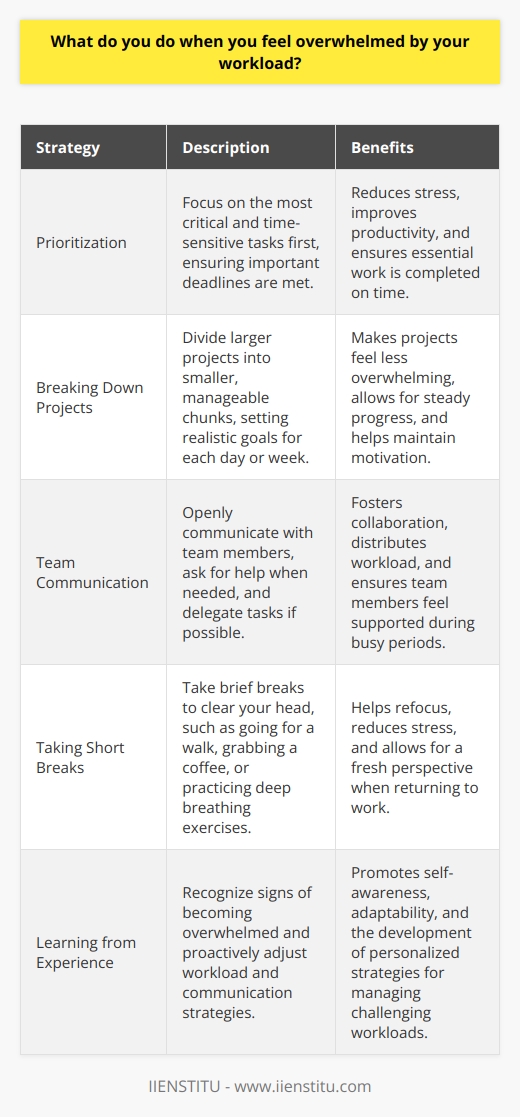
How do you handle the pressure of tight deadlines while maintaining high-quality work?
When faced with tight deadlines, I focus on prioritizing tasks and breaking them down into manageable steps. This helps me stay organized and ensures that I'm making steady progress towards the end goal.
Communication is Key
I also make sure to communicate regularly with my team and stakeholders. If I anticipate any challenges or roadblocks, I bring them up early so we can work together to find solutions. Collaboration is crucial when working under pressure.
Maintaining Quality
To maintain high-quality work, I set mini-milestones for myself and review my progress at each checkpoint. This allows me to catch any errors or areas for improvement early on, rather than rushing at the end and compromising quality.
Staying Calm and Focused
When the pressure is on, I take short breaks to recharge and refocus. Something as simple as stepping away from my desk for a few minutes or doing some deep breathing exercises can make a big difference in my stress levels and productivity.
Learning from Experience
Over time, I've learned to anticipate potential roadblocks and build in buffer time for unexpected issues. Experience has taught me that even the best-laid plans can go awry, so it's important to be adaptable and have contingency plans in place.
At the end of the day, handling tight deadlines is about staying organized, communicating effectively, and maintaining a positive attitude. It's not always easy, but with practice and perseverance, it's definitely achievable.
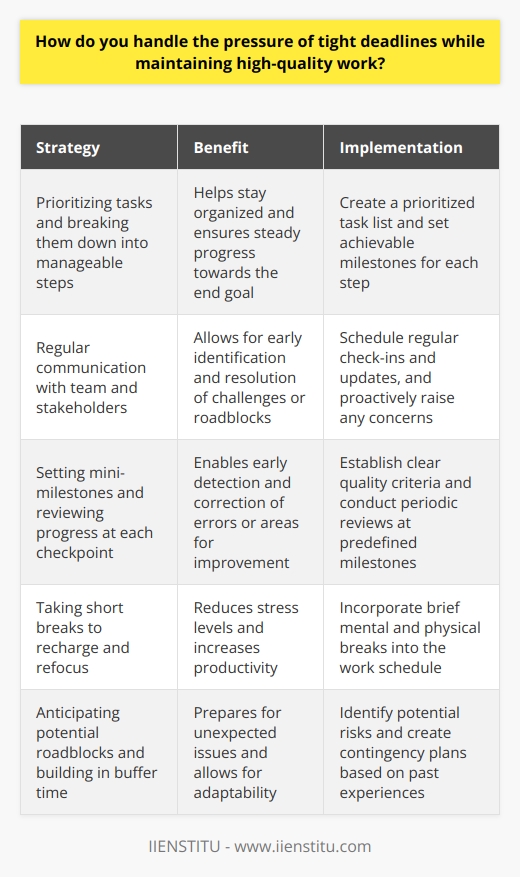
How do you avoid procrastination when working on important but non-urgent tasks?
When it comes to tackling important but non-urgent tasks, I have a few strategies that help me avoid procrastination. First and foremost, I break down the task into smaller, manageable chunks. This makes it feel less overwhelming and allows me to focus on one step at a time.
Setting Deadlines and Rewards
I also find it helpful to set myself deadlines for each chunk of the task. Having a clear timeline keeps me accountable and motivated to stay on track. Additionally, I like to reward myself for completing each milestone. It could be something as simple as taking a short break or treating myself to a favorite snack.
Prioritizing and Scheduling
Another key aspect of avoiding procrastination is prioritizing my tasks effectively. I assess the importance and urgency of each task and tackle the most crucial ones first. This ensures that I'm making steady progress on my important goals, even if they're not immediately pressing.
I also make sure to schedule dedicated time for these tasks in my calendar. Blocking off specific hours for focused work helps me stay committed and reduces the temptation to procrastinate.
Minimizing Distractions
Lastly, I try to create an environment that minimizes distractions. This might involve finding a quiet workspace, turning off notifications on my devices, or even using productivity apps to block certain websites during work hours. By eliminating potential distractions, I can fully immerse myself in the task at hand and maintain my focus.
Overall, avoiding procrastination on important but non-urgent tasks requires a combination of planning, self-discipline, and creating the right environment. By implementing these strategies consistently, I've been able to tackle even the most daunting projects with confidence and efficiency.

What role does planning and goal-setting play in your time management approach?
Planning and goal-setting are essential components of my time management approach. I believe that having clear, well-defined goals is crucial for staying focused and productive.
Setting SMART Goals
When setting goals, I always make sure they are SMART: Specific, Measurable, Achievable, Relevant, and Time-bound. This helps me break down larger objectives into manageable tasks and track my progress along the way.
Prioritizing Tasks
Once I have my goals in place, I prioritize my tasks based on their importance and urgency. I use the Eisenhower Matrix to categorize tasks into four quadrants: urgent and important, important but not urgent, urgent but not important, and neither urgent nor important.
Creating a Schedule
With my prioritized task list, I create a daily and weekly schedule that allocates specific time blocks for each activity. I find that having a structured plan helps me stay on track and avoid procrastination.
Flexibility and Adaptability
While I believe in the power of planning, I also understand the importance of being flexible and adaptable. Life can be unpredictable, and sometimes unexpected challenges arise. When this happens, I reassess my priorities and adjust my plan accordingly.
In my experience, taking the time to plan and set goals has been a game-changer for my productivity and success. It helps me stay focused, motivated, and in control of my time, even when things get busy or stressful.
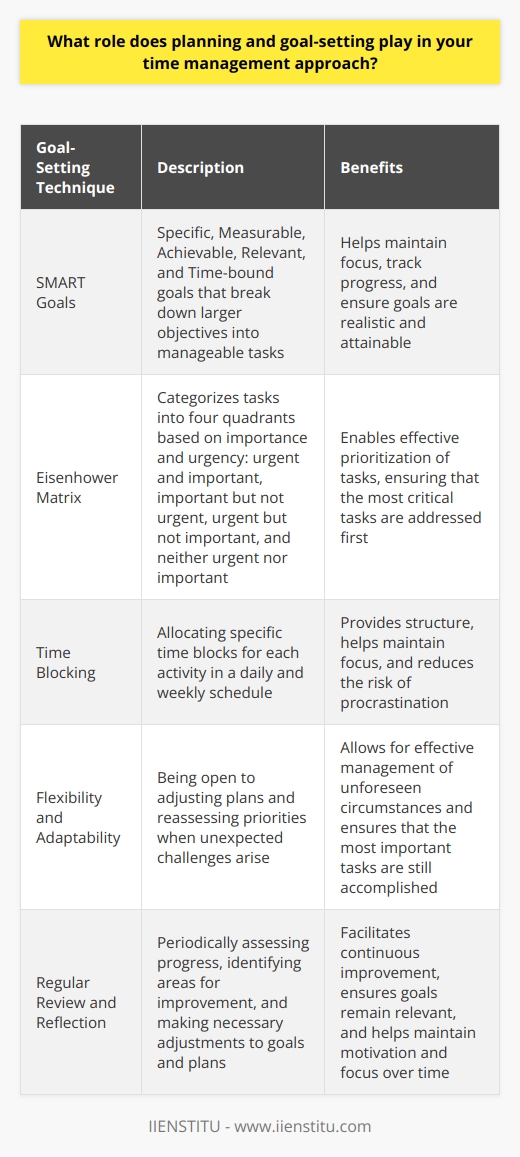
How do you adapt your time management strategies to different types of projects or tasks?
When it comes to adapting my time management strategies for different projects or tasks, I always start by assessing the scope and complexity of the work at hand. This helps me determine how much time and effort will be required to complete the task successfully.
Prioritizing Tasks
Once I have a clear understanding of the project, I prioritize the tasks based on their urgency and importance. I use my judgment and experience to decide which tasks need to be tackled first and which ones can wait. This allows me to focus my energy on the most critical aspects of the project and ensure that I'm making the best use of my time.
Breaking Down Complex Projects
For larger, more complex projects, I break them down into smaller, manageable chunks. This makes the work feel less overwhelming and allows me to track my progress more easily. I set realistic deadlines for each stage of the project and hold myself accountable for meeting those deadlines.
Staying Flexible
Of course, even the best-laid plans can go awry, so I always try to stay flexible and adapt my approach as needed. If I encounter unexpected challenges or setbacks, I don't hesitate to re-evaluate my priorities and adjust my timeline accordingly. The key is to remain agile and responsive, rather than getting bogged down in a rigid plan that no longer serves the project's needs.
Leveraging Technology
Finally, I'm a big believer in leveraging technology to streamline my time management process. I use tools like project management software, calendars, and to-do lists to keep myself organized and on track. These tools help me collaborate more effectively with my team members and ensure that everyone is working towards the same goals.
At the end of the day, effective time management is all about being proactive, adaptable, and focused. By tailoring my approach to the specific needs of each project, I'm able to deliver high-quality work on time and on budget, no matter what challenges come my way.
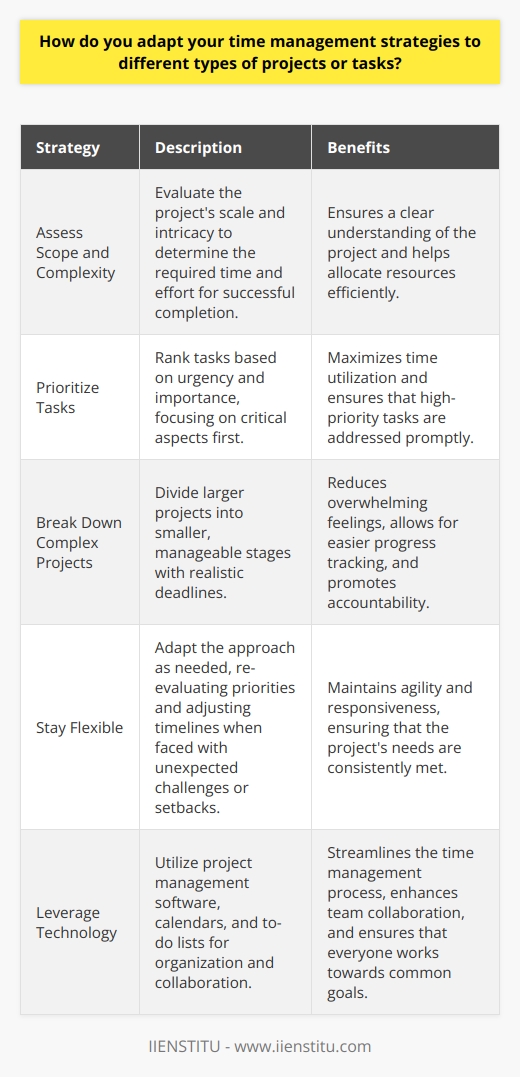
Can you describe a time when you had to work on multiple important projects simultaneously?
Throughout my career, I've had to juggle multiple high-priority projects on several occasions. One memorable example was when I worked as a marketing coordinator at a fast-paced startup.
Prioritizing and Planning
When faced with competing deadlines, I first assess each project's importance and urgency. I then create a detailed plan, breaking down tasks into manageable steps and setting realistic milestones.
Effective Communication
Clear communication is key when managing multiple projects. I keep stakeholders informed of progress, potential obstacles, and any adjustments to the timeline. Regular check-ins ensure everyone stays on the same page.
Adaptability and Problem-Solving
Unexpected challenges are inevitable when juggling projects. I stay calm under pressure and think creatively to find solutions. Adapting to changing circumstances is crucial for keeping projects on track.
Time Management and Organization
Effective time management is essential for success. I use tools like calendars, to-do lists, and project management software to stay organized. I also set aside dedicated blocks of time for each project.
Collaboration and Delegation
Working on multiple projects often means collaborating with different teams. I foster positive relationships, value each person's contributions, and delegate tasks when appropriate. Trusting my colleagues helps me focus on the big picture.
In the end, through careful planning, open communication, and a bit of flexibility, I was able to successfully deliver all the projects on time. It was a challenging experience, but incredibly rewarding to see the team's hard work pay off.
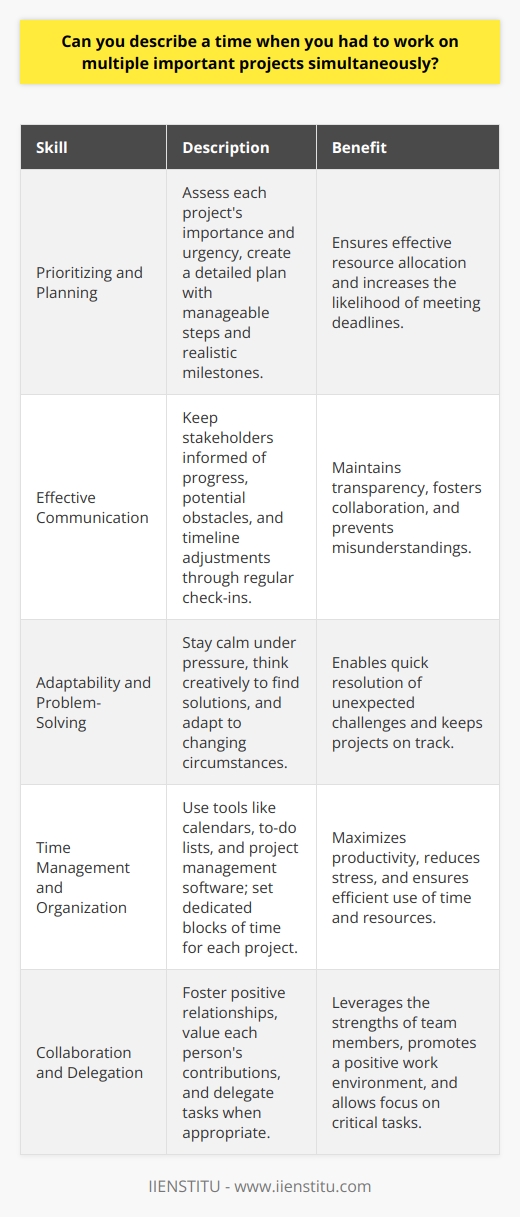
How do you ensure that you're making progress on long-term goals while handling day-to-day responsibilities?
Balancing long-term goals with daily responsibilities is crucial for success. I've found that setting clear priorities is key. Each week, I identify the most critical tasks that align with my long-term objectives. This helps me focus my time and energy effectively.
Staying Organized
To stay on track, I use a planner to break down big goals into smaller, manageable steps. I schedule dedicated time blocks for important projects, ensuring steady progress. Regular check-ins help me assess my progress and adjust as needed.
Communicating with My Team
Open communication is essential. I keep my team informed about my priorities and deadlines. We collaborate to delegate tasks and support each other's goals. By working together efficiently, we can handle daily demands while driving long-term success.
Maintaining Flexibility
Of course, unexpected challenges can arise. I've learned to be adaptable and re-evaluate priorities when necessary. If an urgent issue requires immediate attention, I address it promptly. Then, I refocus on my long-term goals, making adjustments to timelines if needed.
Continuous Learning and Growth
I'm committed to personal and professional development. I set aside time for learning opportunities that support my long-term aspirations. Whether it's attending workshops, reading industry publications, or seeking mentorship, I believe in continuously expanding my skills and knowledge.
By staying organized, communicating effectively, maintaining flexibility, and prioritizing personal growth, I'm able to make consistent progress on long-term goals while successfully managing daily responsibilities. It's a balancing act, but with the right strategies in place, it's achievable.
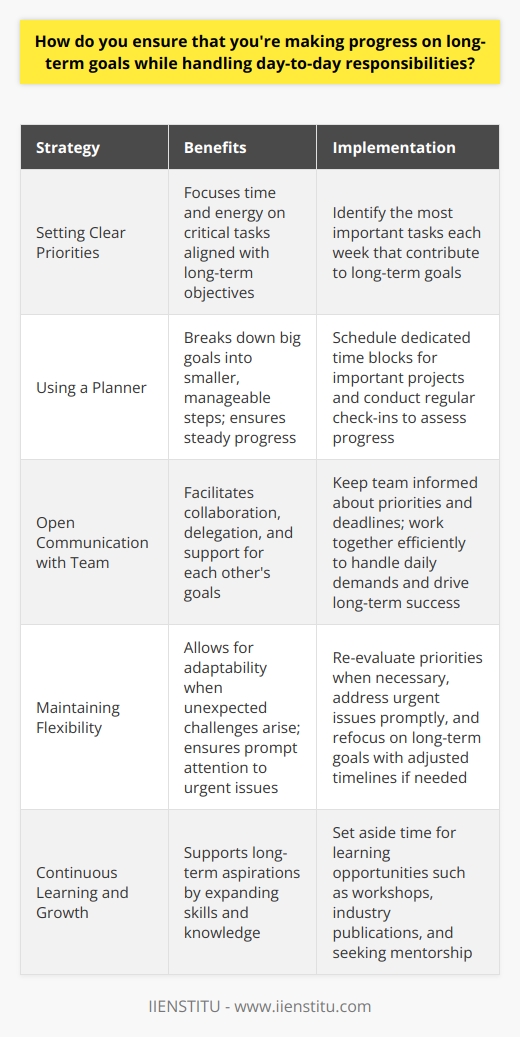
What do you do when you're given an urgent task that conflicts with a pre-existing priority?
When faced with an urgent task that conflicts with a pre-existing priority, I take a moment to assess the situation. I consider the potential impact and consequences of each task and determine which one is truly more critical.
Communicating with Stakeholders
I communicate openly with my manager or the stakeholders involved in both tasks. I explain the conflict and seek their input on prioritization. Their insights help me make an informed decision.
Collaborating with Colleagues
If possible, I explore delegating or sharing responsibilities with teammates. Collaborating can help address both tasks efficiently. I'm always willing to support my colleagues and work together to meet our goals.
Managing Expectations
Regardless of which task takes precedence, I keep all parties updated on progress and any changes in timeline. Managing expectations is key to maintaining trust and positive working relationships, even when priorities shift.
Staying Organized and Focused
Throughout the process, I stay organized and focused. I break down tasks into manageable steps and work diligently. Staying calm under pressure helps me think clearly and adapt to changing demands.
In my experience, balancing urgent tasks with existing priorities is a common challenge. By assessing the situation objectively, communicating proactively, and staying flexible, I aim to navigate these conflicts effectively and deliver strong results.

How do you decide when to delegate tasks to others in order to manage your own time more effectively?
When deciding to delegate tasks, I consider several factors. First, I assess the skills and experience of my team members. If someone has expertise in a particular area, I'm more likely to delegate related tasks to them. This allows me to focus on my core responsibilities while ensuring the task is completed effectively.
Prioritizing Tasks
I also prioritize tasks based on their importance and urgency. If a task is critical to the success of a project but doesn't require my direct involvement, I'll delegate it to a capable team member. This frees up my time to tackle high-priority items that demand my attention.
Empowering Team Members
Another factor I consider is the opportunity for growth and development. By delegating challenging tasks to team members, I provide them with chances to acquire new skills and take on more responsibility. This not only helps them grow professionally but also boosts their motivation and engagement.
Effective Communication
When delegating tasks, I make sure to provide clear instructions and expectations. I communicate the desired outcomes, deadlines, and any necessary resources or support. Regular check-ins and feedback sessions ensure that the delegated tasks remain on track and allow for any necessary adjustments.
Trusting the Team
Ultimately, effective delegation relies on trust. I trust my team members to take ownership of their assigned tasks and deliver quality work. By fostering a culture of trust and accountability, I can confidently delegate tasks, knowing that my team will rise to the challenge.

Can you give an example of a time when you had to say no to an urgent request in order to focus on a more important task?
In my previous role as a project manager, I once had to decline an urgent request from a client to focus on a more critical task. The client wanted me to prioritize their project over others, but I knew that doing so would jeopardize our team's ability to meet a crucial deadline for another high-profile client.
Assessing Priorities
I carefully assessed the priorities and impact of each project. While the requesting client's project was important, the other project had a more significant long-term impact on our company's success and reputation.
Communicating with Empathy
I called the client personally to explain the situation. I acknowledged their request's urgency but also transparently shared why I couldn't accommodate it without compromising another key commitment.
Offering Alternative Solutions
Instead of simply saying no, I proposed alternative solutions. I offered to rearrange some internal resources to support their project better once we met the critical deadline.
The Outcome
The client appreciated my honesty and effort to find a mutually beneficial solution. By focusing on the more important task, our team successfully delivered the high-profile project on time, which led to additional business opportunities with that client.
This experience taught me the importance of prioritization, transparent communication, and problem-solving in managing competing demands. It's not always easy to say no, but sometimes it's necessary for the greater good of the team and the company.

How do you handle the temptation to multitask when working on important projects?
When faced with the temptation to multitask on important projects, I have a few strategies that help me stay focused.
Prioritize and Plan
First, I prioritize my tasks and create a clear plan of action. I break the project down into smaller, manageable steps. This helps me concentrate on one thing at a time and reduces the urge to jump between tasks.
Eliminate Distractions
I also eliminate distractions as much as possible. I close unnecessary browser tabs, silence my phone, and find a quiet workspace. When I'm in the zone, I can give my full attention to the task at hand.
Take Breaks
Surprisingly, taking regular breaks actually boosts my productivity. Stepping away from my desk for a few minutes helps me recharge. I come back with fresh eyes and renewed focus, ready to tackle the next part of the project.
Hold Myself Accountable
Finally, I hold myself accountable. I set personal deadlines and check in with myself throughout the day. Am I making progress? Am I getting sidetracked by less important tasks? Being honest with myself keeps me on track.
In my experience, resisting the multitasking temptation is all about discipline and self-awareness. By staying organized, minimizing distractions, recharging when needed, and monitoring my own progress, I'm able to give important projects the singular focus they deserve.
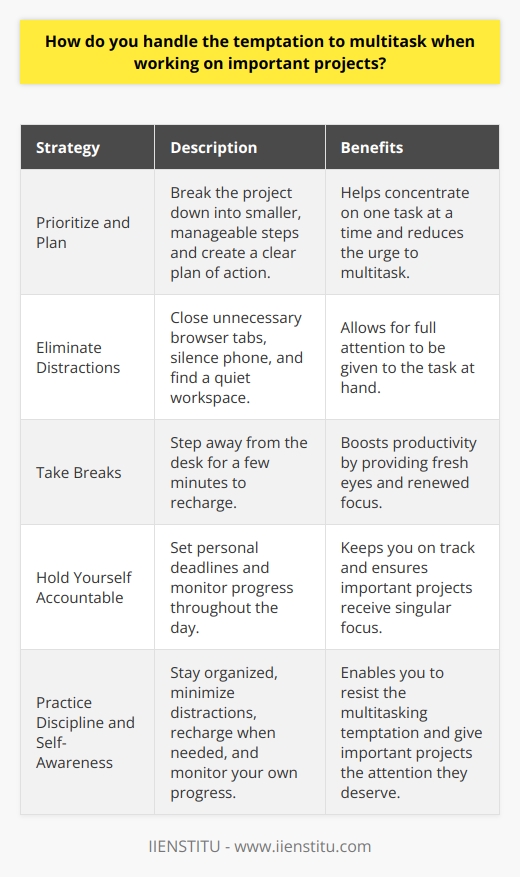
What strategies do you use to minimize distractions and stay focused on high-priority work?
When it comes to staying focused on high-priority work, I have a few tried-and-true strategies that help me minimize distractions.
Prioritize and Plan
First, I always make sure to prioritize my tasks based on their importance and urgency. I create a daily to-do list and tackle the most critical items first. This helps me stay on track and avoid getting sidetracked by less important tasks.
Eliminate Distractions
I also try to eliminate as many distractions as possible. This means closing unnecessary browser tabs, silencing my phone, and finding a quiet workspace. If I'm working on a particularly challenging task, I might even put on noise-canceling headphones to block out any background noise.
Take Breaks
Another strategy I use is to take regular breaks throughout the day. I find that stepping away from my work for a few minutes helps me recharge and refocus. I might take a quick walk around the block, do some stretching, or chat with a coworker.
Use Time-Blocking
I also use a technique called time-blocking, where I dedicate specific chunks of time to certain tasks. For example, I might block off two hours in the morning for writing, and then another hour in the afternoon for responding to emails. This helps me stay focused and avoid multitasking, which can be a major productivity killer.
Stay Accountable
Finally, I find that staying accountable to someone else can be a great motivator. Whether it's a coworker, a manager, or even a friend, knowing that someone else is counting on me to get my work done helps me stay on track and avoid procrastination.
By using these strategies consistently, I've been able to minimize distractions and stay focused on my high-priority work, even in busy and challenging work environments.
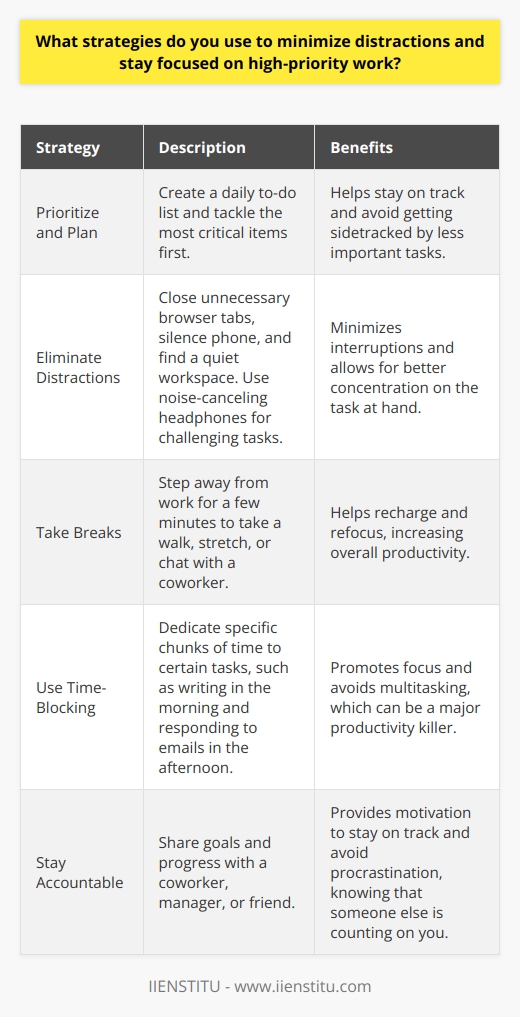
How do you prioritize your own self-care and stress management while handling a heavy workload?
I believe that self-care and stress management are essential for maintaining productivity and well-being in a demanding work environment. Here are some strategies I use to prioritize my own well-being while handling a heavy workload:
Setting Boundaries and Realistic Expectations
I communicate openly with my team and managers about my capacity and limitations. I set realistic deadlines and avoid overcommitting myself. When I feel overwhelmed, I speak up and ask for support or adjustments to my workload.
Practicing Mindfulness and Stress-Reduction Techniques
I incorporate mindfulness practices like deep breathing, meditation, or short walks into my daily routine. These help me stay grounded and manage stress effectively. I also make sure to take regular breaks throughout the day to recharge and refocus.
Engaging in Hobbies and Social Support
Outside of work, I make time for hobbies and activities that bring me joy and relaxation. Whether it's playing music, reading a book, or spending time with loved ones, these outlets help me maintain a healthy work-life balance and reduce stress levels.
Prioritizing Self-Care Habits
I prioritize self-care habits like getting enough sleep, eating nutritious meals, and exercising regularly. These habits help me maintain my physical and mental well-being, which in turn enhances my ability to handle stress and perform at my best.
By implementing these strategies consistently, I've found that I'm able to manage even the most demanding workloads while still taking care of myself. It's an ongoing process, but one that I'm committed to for the sake of my long-term success and well-being.
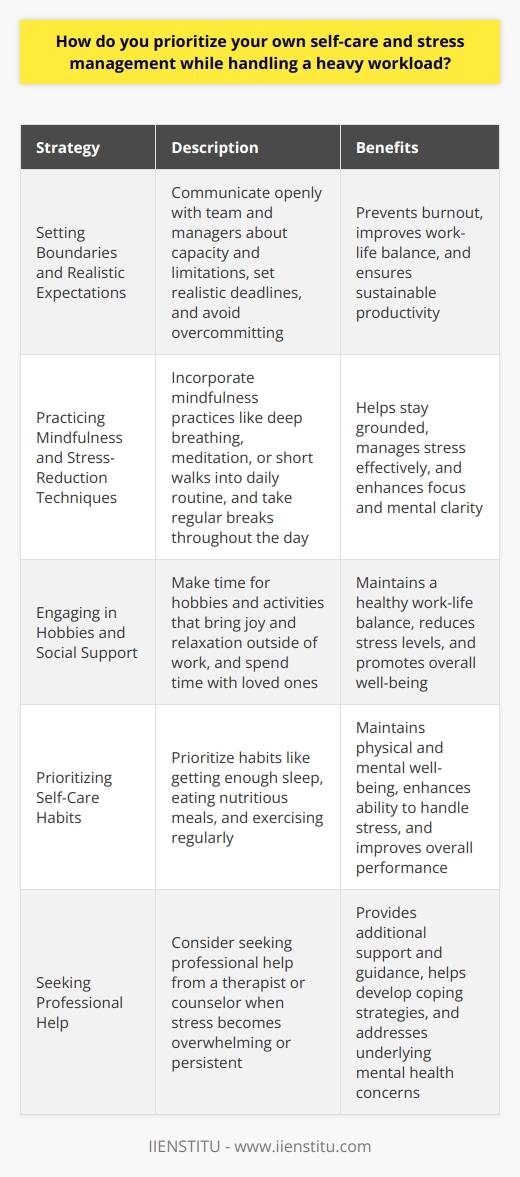
Can you describe a time when you had to adjust your priorities mid-project due to changing circumstances?
In my previous role as a marketing coordinator, I was tasked with organizing a product launch event. Halfway through the planning process, our main sponsor unexpectedly withdrew their support. This sudden change forced me to quickly reassess the situation and adjust my priorities.
Reevaluating the Budget
I immediately sat down with my team to reevaluate our budget. We looked for areas where we could cut costs without compromising the overall quality of the event. This meant renegotiating contracts with vendors and finding alternative solutions for certain elements of the launch.
Seeking New Sponsors
At the same time, I reached out to my network to seek out potential new sponsors. I crafted personalized proposals highlighting the benefits of partnering with our company for the product launch. Through persistence and persuasive communication, I managed to secure two new sponsors within a short timeframe.
Adjusting the Event Plan
With the updated budget and new sponsors on board, I worked closely with my team to adjust our event plan. We streamlined certain aspects of the launch while still ensuring that the core message and impact remained intact. It required creativity, flexibility, and a willingness to adapt to the changing circumstances.
Successful Outcome
Despite the initial setback, the product launch event was a success. By quickly adjusting my priorities and finding innovative solutions, I was able to deliver a memorable experience for our attendees and stakeholders. This experience taught me the importance of being agile and adaptable in the face of unexpected challenges.

How do you ensure that you're dedicating enough time to both urgent and important tasks?
I believe that effective time management is crucial for success in any role. To ensure that I'm dedicating enough time to both urgent and important tasks, I follow a few key strategies:
Prioritize and Plan
At the start of each day or week, I take a few minutes to prioritize my tasks based on their urgency and importance. I use a simple matrix to categorize them into four quadrants: urgent and important, important but not urgent, urgent but not important, and neither urgent nor important. This helps me focus on the most critical tasks first.
Once I have my priorities straight, I create a realistic plan for tackling them. I break larger projects into smaller, manageable steps and allocate specific time blocks for each task on my calendar. This helps me stay on track and avoid getting overwhelmed.
Be Flexible and Adaptable
Of course, even the best-laid plans can go awry. Unexpected issues or opportunities often arise, forcing me to adjust my priorities on the fly. When this happens, I try to stay calm and flexible. I quickly reassess the situation and make any necessary changes to my plan.
If an urgent matter requires my immediate attention, I handle it promptly. However, I'm careful not to let these interruptions derail my entire day. As soon as the fire is put out, I refocus on my important tasks.
Communicate and Delegate
Effective communication is key to managing my time and workload. If I'm feeling overwhelmed or need help with a task, I'm not afraid to speak up. I keep my team and manager informed about my progress, challenges, and any potential delays.
When appropriate, I also delegate tasks to others. This not only helps me manage my own time better but also empowers my colleagues and promotes teamwork.
By following these strategies consistently, I'm able to strike a healthy balance between urgent and important tasks, meet my deadlines, and deliver high-quality work.
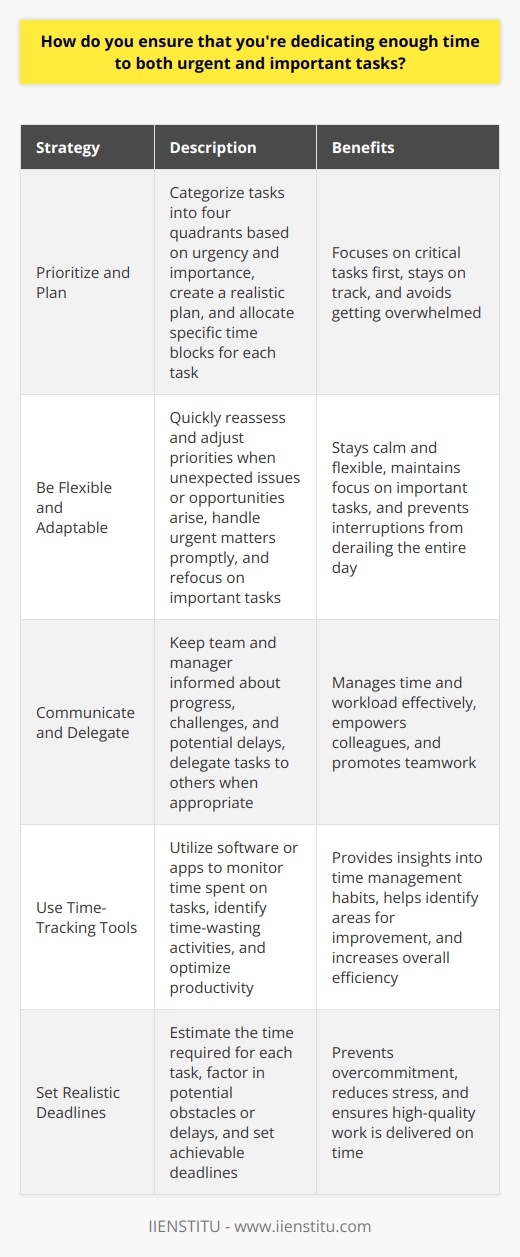
What do you do when you disagree with a manager or client about the priority of a task?
When disagreeing with a manager or client about task priority, I first seek to understand their perspective. Active listening helps me grasp their reasoning behind the prioritization. I then respectfully express my viewpoint, using facts and data to support my stance.
Collaborate on a Solution
After exchanging viewpoints, I suggest collaborating to find a mutually beneficial solution. By working together, we can often discover creative ways to address both priorities. I've found that open communication and a willingness to compromise lead to positive outcomes.
Adapt and Stay Flexible
Ultimately, if the manager or client still feels strongly about their priority, I adapt my approach. I trust their judgment and expertise. Flexibility is key in these situations. I focus on executing the task to the best of my abilities, while keeping the bigger picture in mind.
Learn and Grow
Every disagreement is a chance for growth. I reflect on what I can learn from the experience. Perhaps I need to improve how I communicate my perspective. Or maybe I can enhance my problem-solving skills. Continuous learning helps me handle future disagreements with grace and professionalism.
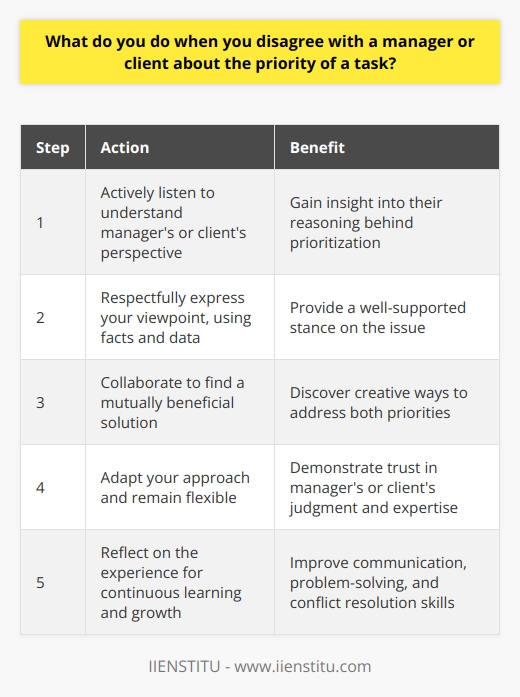
How do you handle the pressure of multiple stakeholders with competing priorities?
When faced with the pressure of multiple stakeholders with competing priorities, I approach the situation with a calm and analytical mindset. I believe in open communication and active listening to fully understand each stakeholder's needs and concerns.
Prioritizing and Planning
I assess the urgency and impact of each priority and create a prioritized list. This helps me allocate my time and resources effectively. I also break down complex tasks into manageable steps and set realistic deadlines.
Collaborating and Negotiating
I actively engage with stakeholders to find common ground and explore win-win solutions. I'm not afraid to have difficult conversations and negotiate compromises when necessary. I've found that fostering a collaborative spirit helps build trust and alignment.
Adapting and Communicating
I stay flexible and adapt my approach as circumstances change. I keep stakeholders informed of progress and any challenges that arise. Regular updates and transparent communication are key to managing expectations and maintaining positive relationships.
Focusing on the Big Picture
Throughout the process, I keep the overarching goals and objectives in mind. I make decisions based on what's best for the project and the organization as a whole. By staying focused on the big picture, I can navigate competing priorities more effectively.
In my experience, handling the pressure of multiple stakeholders requires a combination of strong prioritization skills, effective communication, and a willingness to collaborate and adapt. It's a challenging but rewarding aspect of my work, and I'm confident in my ability to manage it successfully.
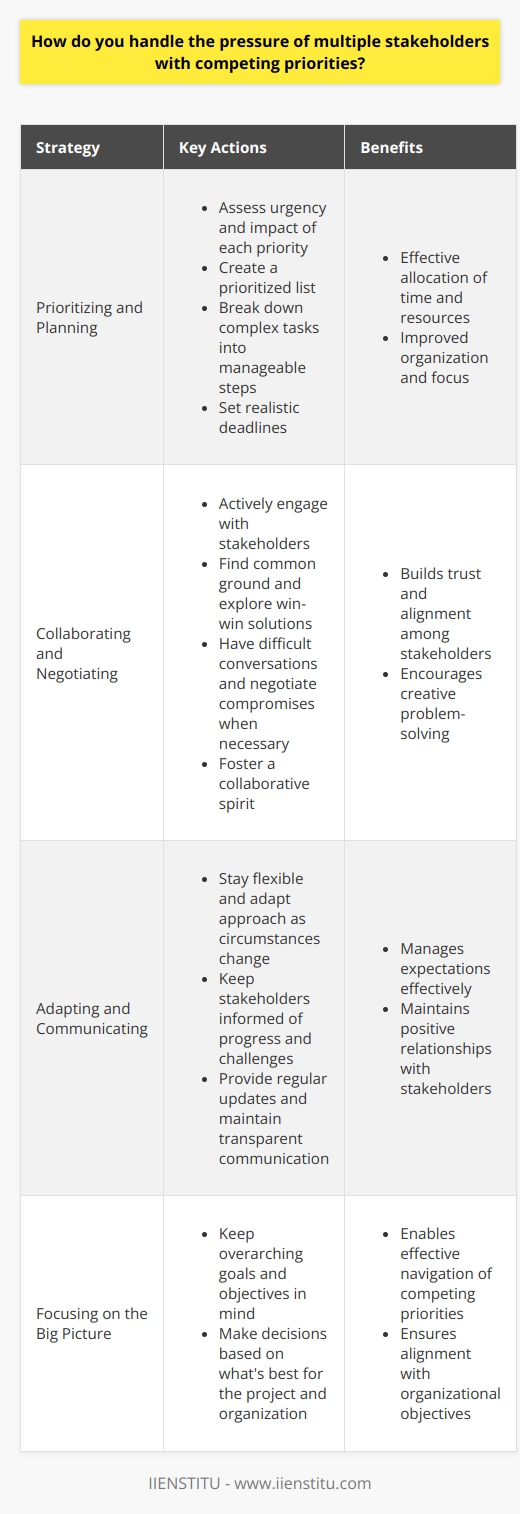
How do you prioritize tasks when working on a project with a tight budget or limited resources?
When working on a project with limited resources, I prioritize tasks based on their impact and urgency. I start by identifying the most critical tasks that directly contribute to the project's success. These are the tasks that I tackle first.
Assess the Urgency and Importance of Each Task
I evaluate each task's deadline and its significance to the overall project. Urgent tasks with approaching deadlines get higher priority. Similarly, tasks that have a significant impact on the project's outcome are given more attention.
Break Down Tasks into Smaller, Manageable Steps
To make the most of the available resources, I break down larger tasks into smaller, actionable steps. This allows me to allocate resources efficiently and ensures that progress is made consistently.
Collaborate with the Team
I believe in the power of collaboration. I work closely with my team members to identify areas where we can support each other. By leveraging each other's strengths, we can optimize our limited resources and achieve better results.
Continuously Monitor and Adjust
Throughout the project, I regularly assess our progress and make necessary adjustments. If a task is taking longer than expected or if new priorities emerge, I adapt our plan accordingly. Flexibility is key when working with tight budgets and limited resources.
In my previous role, I successfully managed a project with a tight deadline and budget constraints. By prioritizing tasks, collaborating with my team, and staying agile, we delivered the project on time and within budget. It was a challenging experience, but it taught me valuable lessons in resource management and adaptability.

What strategies do you use to maintain motivation and focus when working on long-term, high-priority projects?
Staying Motivated and Focused on Long-Term Projects
When it comes to maintaining motivation and focus on long-term, high-priority projects, I have a few strategies that have worked well for me. First, I break the project down into smaller, manageable tasks. This helps me feel like I'm making progress and keeps me from getting overwhelmed by the scope of the project.
Setting Milestones and Celebrating Successes
I also set milestones for myself and celebrate when I reach them. For example, when I was working on a year-long research project in college, I set a goal to have the literature review done by the end of the first month. When I achieved that, I treated myself to a nice dinner out with friends. Those small celebrations helped keep me motivated throughout the project.
Collaborating with Others
Another strategy I use is to collaborate with others when possible. Having a team to bounce ideas off of and share the workload with can make a big difference in staying motivated. I remember when I was working on a big marketing campaign at my last job, I made sure to schedule regular check-ins with my team members to keep everyone on track and energized.
Taking Breaks and Practicing Self-Care
Finally, I make sure to take breaks and practice self-care. It's easy to get burned out when working on a long-term project, so I prioritize getting enough sleep, eating well, and taking time to do things I enjoy outside of work. This helps me come back to the project with fresh eyes and renewed energy.
